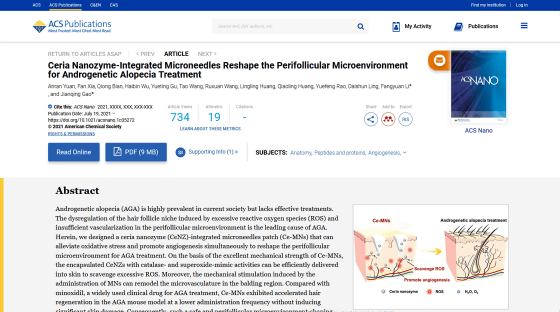A treatment method for baldness that regenerates hair by pasting a 'patch with fine needles' is developed

Ceria Nanozyme-Integrated Microneedles Reshape the Perifollicular Microenvironment for Androgenetic Alopecia Treatment | ACS Nano
https://pubs.acs.org/doi/10.1021/acsnano.1c05272

Treating the'root' cause of baldness with a dissolvable microneedle patch
https://phys.org/news/2021-08-root-baldness-dissolvable-microneedle-patch.html
A common cause of androgenetic alopecia is a stagnation of blood flow around the hair follicles , resulting in a lack of supply of nutrients and cytokines needed for hair growth. Another cause is that the accumulation of active oxygen in the scalp causes the death of hair follicle stem cells required for hair growth due to oxidative stress. However, many hair growth methods that exist in the world do not deal with fundamental problems such as insufficient blood flow and oxidative stress.
A research team at Zhejiang University focused on the fact that cerium- containing nanoparticles can mimic enzymes that remove excess active oxygen and reduce oxidative stress. Because cerium-containing nanoparticles cannot pass through the outermost layers of the skin, the research team set out to develop a treatment that delivers the nanoparticles directly near the hair roots and promotes hair regrowth.

The research team first coated cerium-containing nanoparticles with a biodegradable
Then, we prepared a mouse in which the hair-free part was made with a depilatory cream, and attached a group with 'patches with microneedles containing cerium-containing nanoparticles' and 'patches with drug-free microneedles'. We analyzed how different the hair growth effect was in the group with the above.
Both patches then showed the effect of microneedles physically stimulating the skin near the hair roots, creating new blood vessels. Also, in the group injected with cerium-containing nanoparticles, signs of hair growth from the roots were seen faster, such as early skin pigmentation and an increase in compounds seen when new hair grows. Furthermore, it has been confirmed that mice injected with cerium-containing nanoparticles have less oxidative stress compounds in the skin.
As a result of continuing follow-up after that, a patch with cerium-containing nanoparticles infused was placed more than the group with nanoparticles-free microneedle patches and the group treated with minoxidil, which is a common therapeutic agent. It turned out that the attached mouse grows new hair faster. In addition, the research team said that there was no serious skin damage due to the patch application, and the method of injecting cerium-containing nanoparticles with a microneedle patch is a promising strategy for treating patients with androgenetic alopecia. It states that there is.

Related Posts:
in Science, Posted by log1h_ik







